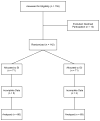Patient comprehension of an interactive, computer-based information program for cardiac catheterization: a comparison with standard information
- PMID: 19901144
- PMCID: PMC2776761
- DOI: 10.1001/archinternmed.2009.390
Patient comprehension of an interactive, computer-based information program for cardiac catheterization: a comparison with standard information
Abstract
Background: Several studies suggest that standard verbal and written consent information for treatment is often poorly understood by patients and their families. The present study examines the effect of an interactive computer-based information program on patients' understanding of cardiac catheterization.
Methods: Adult patients scheduled to undergo diagnostic cardiac catheterization (n = 135) were randomized to receive details about the procedure using either standard institutional verbal and written information (SI) or interactive computerized information (ICI) preloaded on a laptop computer. Understanding was measured using semistructured interviews at baseline (ie, before information was given), immediately following cardiac catheterization (early understanding), and 2 weeks after the procedure (late understanding). The primary study outcome was the change from baseline to early understanding between groups.
Results: Subjects randomized to the ICI intervention had significantly greater improvement in understanding compared with those who received the SI (net change, 0.81; 95% confidence interval, 0.01-1.6). Significantly more subjects in the ICI group had complete understanding of the risks of cardiac catheterization (53.6% vs 23.1%) (P = .001) and options for treatment (63.2% vs 46.2%) (P = .048) compared with the SI group. Several predictors of improved understanding were identified, including baseline knowledge (P < .001), younger age (P = .002), and use of the ICI (P = .003).
Conclusions: Results suggest that an interactive computer-based information program for cardiac catheterization may be more effective in improving patient understanding than conventional written consent information. This technology, therefore, holds promise as a means of presenting understandable detailed information regarding a variety of medical treatments and procedures.
Figures



References
-
- Beauchamp T, Childress J. Principles of biomedical ethics. New York: Oxford University Press; 1994.
-
- Vallance J, Ahmed M, Dhillon B. Cataract surgery and consent; recall, anxiety, and attitude toward trainee surgeons preoperatively and postoperatively. J Cataract Refract Surg. 2004;30:1479–1485. - PubMed
-
- Barrett R. Quality of informed consent: measuring understanding among participants in oncology clinical trials. Oncol Nurs Forum. 2005;32:751–755. - PubMed
-
- Stryker J, Wray R, Emmons K, Winer E, Demetri G. Understanding the decisions of cancer clinical trial participants to enter research studies: Factors associated with informed consent, patient satisfaction, and decisional regret. Patient Educ & Counsel. 2005;63:104–109. - PubMed

